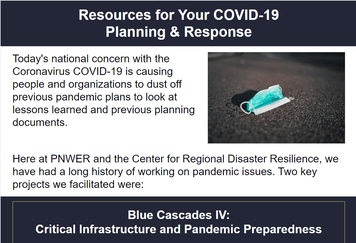Public Health
How ready are you for a pandemic event?
|
Today's national concern with the Coronavirus COVID-19 is causing people and organizations to dust off previous pandemic plans to look at lessons learned and previous planning documents.
Here at the Center for Regional Disaster Resilience, we have had a long history of working on pandemic issues. Check out our resources below and on our COVID-19 Resources page. NEWS: Former King County Disaster Leader: 'We need to take drastic steps now' March 19, 2020 |
|
One way to measure your readiness is to run through this Pandemic Readiness Self-Evaluation Report Card to evaluate your own organization's preparedness.
|
Reports & Scenarios
|
Bio-Event Planning and Critical Infrastructure
Recognizing that private industry, businesses, and other non-governmental organizations constitute integral and essential components of every region, PNWER acknowledges the need to coordinate for a bio-event across the healthcare sector and other organizations with roles in emergency management. This includes work in partnership with the private sector and other key regional stakeholders. Through this understanding, PNWER has led and participated in a number of pandemic and bio-event resilience initiatives. |
2009 – 2010: Comprehensive Community Bio-Event Resilience Initiative
The anthrax attacks of October 2001, followed by the 2003 SARS epidemic and the Influenza A(H1N1) outbreak highlight the critical need for Comprehensive Community Bio-Event Resilience Plan that can provide a holistic approach to cover all aspects of preparedness, medical and other response (including surge capacity), recover and longer-term restoration needs. A significant bio-event would challenge healthcare organizations with dramatic increases in patient load and reductions in available health and medical capacity while at the same time disrupting critical infrastructures and essential service providers on which healthcare organizations depend. In addition, public health agencies must rapidly educate and inform the general population regarding health threats and appropriate protective measures, while maintaining a comprehensive surveillance system and directing medical countermeasure response. As communities recover from disasters, they will experience further impacts if the continuity of critical services and systems, both public and private, is jeopardized due to key staff being absent. Recognizing that private industry, businesses, and other non-governmental organizations constitute integral integral and essential components of every region, a Comprehensive Community Bio-Event Resilience Plan needs to be developed by the healthcare sector and other organizations with roles in emergency management in partnership with the private sector and other key regional stakeholders. Click here for report 2007/2010: Interagency Biological Restoration Demonstration (IBRD) The Departments of Defense and Homeland Security, with the Urban Area Security Initiative (UASI) partnered in a collaborative program aimed at developing ways to recover and restore critical infrastructure in a large urban area after a catastrophic biological attack. In November 2008, PNWER, on behalf of the Pacific Northwest National Lab, along with representatives from Puget Sound Region utilities, businesses, government agencies, and other organizations responsible for providing essential services and disaster response and recovery participated in an interactive workshop. The workshop focused on challenges associated with restoring interdependent critical infrastructures and essential services in the aftermath of a regional bio-attack. The purpose of the workshop was to have public and private representatives from critical infrastructure / key resource sectors from the Puget Sound region join in a cross-sector dialogue to further explore consequences of cascading impacts affecting recovery of the region after a catastrophic biological incident and identify ways to improve regional resilience to a significant bio-attack. 2007: Blue Cascades IV (Pandemic Scenario) A pandemic flu outbreak is one of many threats facing critical infrastructures in the Pacific Northwest. Unlike other threats, a pandemic outbreak does not directly impact physical or cyber assets, rather it impacts the workforce. In the event of a pandemic outbreak the workforce will be diminished significantly. The purpose of the exercise was to build on experience from previous Blue Cascades regional exercises and examine the impact of infrastructure interdependencies that could impede response and recovery from an influenza pandemic. Click here for report |


